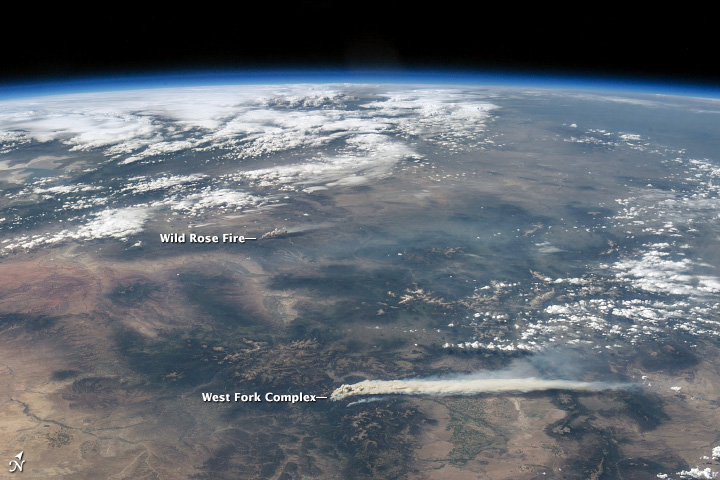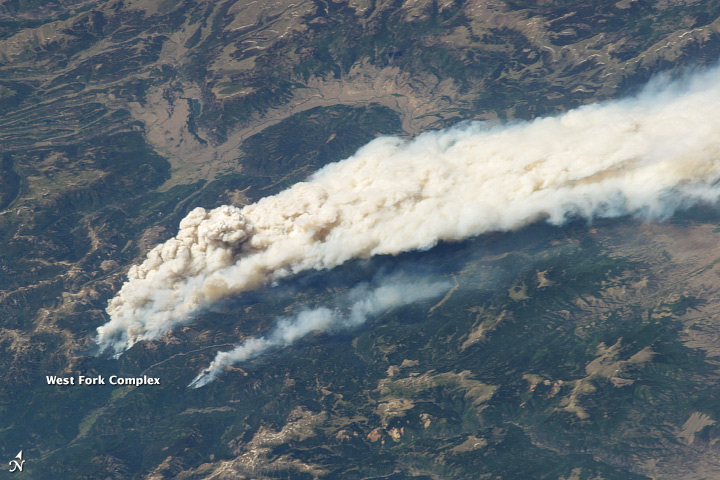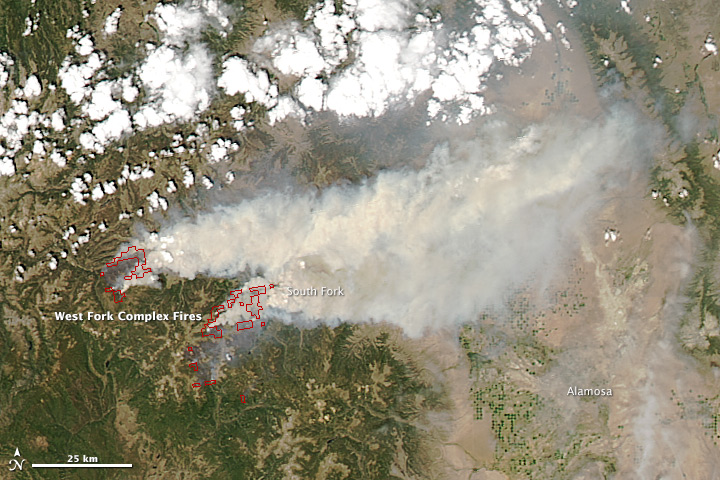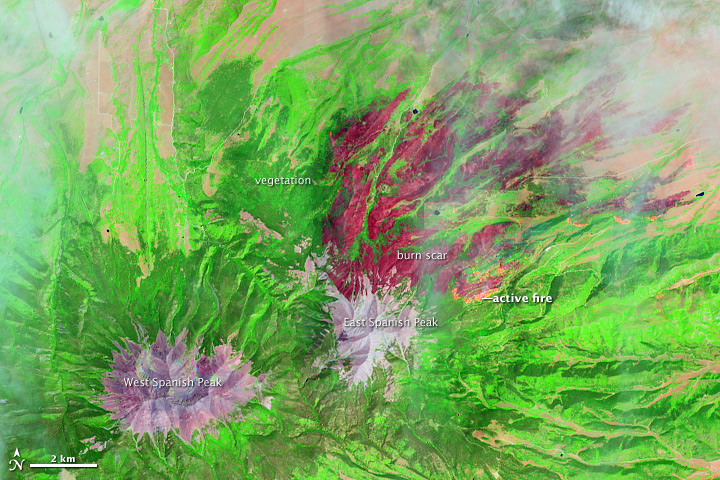
acquired June 19, 2013
download large image (645 KB, JPEG, 1440x960)

acquired June 19, 2013
download large image (360 KB, JPEG, 1440x960)
Thick smoke billows across the
landscape in these digital photographs of the western United States.
Both photographs were taken by astronauts aboard the International Space
Station (ISS) on June 19, 2013.
The images show a plume wafting from the West Fork Complex fire, which was burning explosively in southwestern Colorado near Pagosa Springs. To the northwest, a smaller plume from the Wild Rose fire is also visible (upper image).
While the Wild Rose blaze was fully contained by June 25, 2013, the West Fork Complex was still raging through the San Juan and Rio Grande National Forests. The West Fork Complex is a combination of three fires: the West Fork fire, the Windy Pass fire, and the Papoose fire. Lightning ignited the first of the blazes on June 5, 2013, and together they had charred approximately 75,000 acres (30,000 hectares) by June 25. The fires were burning in rugged terrain with large amounts of beetle-killed spruce forests.
The West Fork Complex fire was so hot that it spawned numerous pyrocumulus clouds—tall, cauliflower-shaped clouds that billowed high above the surface. Pyrocumulus clouds are similar to cumulus clouds, but the heat that forces the air to rise comes from fire instead of sun-warmed ground.
Scientists monitor pyrocumulus clouds closely because they can inject smoke and pollutants high into the atmosphere. As those pollutants are dispersed by wind, they can affect air quality over broad areas. As noted by the University Maryland at Baltimore County (UMBC) Smog Blog, smoke from western fires contributed to elevated concentrations of particulate matter over large sections of the eastern United States.
Preliminary observations by the Cloud-Aerosol Lidar and Infrared Pathfinder Satellite Observations (CALIPSO) satellite indicate the West Fork Complex fire lofted smoke plumes as high as 13.5 kilometers (8.4 miles) into the atmosphere. Satellite observations also show that smoke reached European airspace by June 24.
The images show a plume wafting from the West Fork Complex fire, which was burning explosively in southwestern Colorado near Pagosa Springs. To the northwest, a smaller plume from the Wild Rose fire is also visible (upper image).
While the Wild Rose blaze was fully contained by June 25, 2013, the West Fork Complex was still raging through the San Juan and Rio Grande National Forests. The West Fork Complex is a combination of three fires: the West Fork fire, the Windy Pass fire, and the Papoose fire. Lightning ignited the first of the blazes on June 5, 2013, and together they had charred approximately 75,000 acres (30,000 hectares) by June 25. The fires were burning in rugged terrain with large amounts of beetle-killed spruce forests.
The West Fork Complex fire was so hot that it spawned numerous pyrocumulus clouds—tall, cauliflower-shaped clouds that billowed high above the surface. Pyrocumulus clouds are similar to cumulus clouds, but the heat that forces the air to rise comes from fire instead of sun-warmed ground.
Scientists monitor pyrocumulus clouds closely because they can inject smoke and pollutants high into the atmosphere. As those pollutants are dispersed by wind, they can affect air quality over broad areas. As noted by the University Maryland at Baltimore County (UMBC) Smog Blog, smoke from western fires contributed to elevated concentrations of particulate matter over large sections of the eastern United States.
Preliminary observations by the Cloud-Aerosol Lidar and Infrared Pathfinder Satellite Observations (CALIPSO) satellite indicate the West Fork Complex fire lofted smoke plumes as high as 13.5 kilometers (8.4 miles) into the atmosphere. Satellite observations also show that smoke reached European airspace by June 24.
References
- CIMSS Satellite Blog (2013, June 20) West Fork and East Park fires in southern Colorado. Accessed June 25, 2013.
- InciWeb (2013, June 25) West Fork Complex. Accessed June 25, 2013.
- InciWeb (2013, June 25) Wild Rose. Accessed June 25, 2013.
Further Reading
- Denver Post (2013, June 25) West Fork Complex fire progress dependent on weather. Accessed June 25, 2013.
- NASA Earth Observatory (2010, August 31) Russian Firestorm: Finding a Fire Cloud from Space.
Astronaut photographs
ISS036-E-009725 (top) and ISS036-E-009608 (lower) were acquired on June
19, 2013, and are provided by the ISS Crew Earth Observations experiment
and Image Science & Analysis Laboratory, Johnson Space Center. The
image was taken by the Expedition 36 crew. It has been cropped and enhanced to improve contrast, and lens artifacts have been removed. The International Space Station Program supports the laboratory as part of the ISS National Lab
to help astronauts take pictures of Earth that will be of the greatest
value to scientists and the public, and to make those images freely
available on the Internet. Additional images taken by astronauts and
cosmonauts can be viewed at the NASA/JSC Gateway to Astronaut Photography of Earth. Caption by Adam Voiland.
- Instrument:
- ISS - Digital Camera
West Fork Complex Fires, Colorado

acquired June 22, 2013
download large image (2 MB, JPEG, 1600x1200)
acquired June 22, 2013
download GeoTIFF file (4 MB, TIFF)
acquired June 22, 2013
download Google Earth file (KMZ)
On June 22, 2013, the Moderate Resolution Imaging Spectroradiometer (MODIS) on NASA’s Aqua satellite captured this image of the West Fork
fire complex burning in the San Juan and Rio Grande National Forests of
southwestern Colorado. Red outlines indicate hot spots where MODIS
detected unusually warm surface temperatures associated with fire. The
fires were burning in rugged terrain with large amounts of beetle-killed spruce forests. South Fork, a nearby town with about 400 people, has been evacuated.
Further Reading
- Inciweb. (2013, June 24) West Fork Complex. Accessed June 24, 2013.
- Denver Post (2013, June 23) West Fork fire complex in Colorado feeding on beetle-ravaged forests. Accessed June 24, 2013.
- KDVR (2013, June 24) West Fork Complex shows no sign of relenting. Accessed June 24, 2013.
- Earth Observatory (2012, July 28) Tiny Beetles Take a Large Bite Out of the Forest.
NASA image courtesy Jeff Schmaltz, LANCE MODIS Rapid Response Team at NASA GSFC. Caption by Adam Voiland.
- Instrument:
- Aqua - MODIS
East Peak Fire Burn Scar, Colorado

acquired June 22, 2013
download large image (4 MB, JPEG, 2517x2517)
acquired June 22, 2013
download GeoTIFF file (14 MB, TIFF)
On June 22, 2013, the Operational Land Imager (OLI) on Landsat 8 captured this false-color image of the East Peak fire burning in southern Colorado near Trinidad.
Burned areas appear dark red, while actively burning areas look orange.
Dark green areas are forests; light green areas are grasslands.
Lightning ignited the blaze on June 19, 2013. By June 25, it had burned nearly 13,500 acres (5,500 hectares).
References
- InciWeb (2013, June 24) East Peak. Accessed June 25, 2013.
Further Reading
- Denver Post (2013, June 23) East Peak gets a controlled burn from firefighter in Colorado. Accessed June 25, 2013.
NASA Earth Observatory image by Jesse Allen and Robert Simmon, using Landsat data from the U.S. Geological Survey. Caption by Adam Voiland.
- Instrument:
- Landsat 8 - OLI
NASA: USA - Astronaut View of Fires in Colorado - West Fork Complex Fires - East Peak Fire Burn Scar - 08.07.13
Ricardo M Marcenaro - Facebook
Blogs in operation of The Solitary Dog:
Solitary Dog Sculptor: byricardomarcenaro.blogspot.com
Solitary Dog Sculptor I: byricardomarcenaroi.blogspot.com/
Para:
comunicarse conmigo,
enviar materiales para publicar,
propuestas comerciales:
comunicarse conmigo,
enviar materiales para publicar,
propuestas comerciales:
marcenaroescultor@gmail.com
For:
contact me,
submit materials for publication,
commercial proposals:
For:
contact me,
submit materials for publication,
commercial proposals:
marcenaroescultor@gmail.com
My blogs are an open house to all cultures, religions and countries. Be a follower if you like it, with this action you are building a new culture of tolerance, open mind and heart for peace, love and human respect. Thanks :)
Mis blogs son una casa abierta a todas las culturas, religiones y países. Se un seguidor si quieres, con esta acción usted está construyendo una nueva cultura de la tolerancia, la mente y el corazón abiertos para la paz, el amor y el respeto humano. Gracias:)
(::)

No hay comentarios:
Publicar un comentario